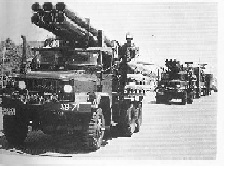Engineering:Bongbong (rocket)
 | |
| Function | Research rocket |
|---|---|
| Country of origin | Philippines |
| Launch history | |
| Status | Retired |
| Launch sites | Caballo island Fort Magsaysay |
| Total launches | 37 |
| Successes | Unknown |
| First flight | 1972 |
Bongbong was a experimental Philippine liquid-propellant rocket developed under Project Santa Barbara.[1] The rocket was an experimental system developed by the Philippine Navy, engineers, and a group of scientists that could range up to 12 km.[2] The rocket was named after the son of then-President Ferdinand Marcos, Bongbong Marcos.
History
The rocket was first successfully launched on March 12, 1972 and the rocket was successfully retrieved from the South China Sea.[3] Though sources are scant, the rocket launch was chronicled by NASA in its 1972 publication of "Astronautics and Aeronautics". However, in this publication, the rocket is referred to as "Bong Bong II".[4][5] The rocket was mainly tested in Caballo island, though four of the tests were held at Fort Magsaysay.[citation needed]
The fate of the project, as well as its blueprints since its retirement, remains unknown.[6]
Project Santa Barbara includes the Ballistic Missile Project, Multiple Rocket Launcher, Anti-Air Missile, Anti-Ship Missile, Anti-Typhoon Rockets. As for the Ballistic Missile Experimental Rockets, 37 Successful Tests of the Rocket Prototype was Conducted since first Successful Test in 1972. Only One Guided Rocket System, the Anti-Typhoon Rockets and One Multiple Rocket Launcher systems are revealed to the Public.
Bukang Liwayway Multiple Rocket Launcher
Bukang Liwayway is an unguided 180mm Surface-to-Surface Rocket System. It was researched and developed by a group of Filipino and German engineers and scientists.[7]
Sumpak Multiple Rocket Launcher
The Mk. 40 Sumpak was an trailer mounted modular MRL system initially developed by the PAF SDRDG in 1981. Modified as a truck-mounted version, which greatly enhanced its mobility and stability, it was intended for various applications such as point defense and shore-to-ship emplacement, firing standard 70 mm HEAT, and FFAR. It was named previously named as "Mobile Assault Rocket Combat Operational System" or MARCOS. but it was then changed to "Sumpak".[7]
Anti-typhoon Missiles
It has currently limited information of that rocket since that project is still a state secret. Col. Ramon Macabuhay said firing the could-seeding missiles from a distance will protect the pilot and the aircraft from the hazards and turbulence of storm clouds — in short, eliminate the need of flying the plane right into the typhoon. The missiles is similar to the surface-to-air missiles used in warfare, but instead of an explosive warhead, it will have a wooden rocket head containing approximately half a pound of silver iodide.[1]
References
- ↑ 1.0 1.1 Ago, Alwinvhonzin #history • 3 Years (2018-02-27). "The Secret Weapon of the Philippines 1970's." (in en). https://steemit.com/history/@alwinvhonz/the-secret-weapon-of-the-philippines-1970-s.
- ↑ "Santa Barbara Project - The Classified Missile Project of the Philippines". http://kbl.org.ph/what-is-a-santa-barbara-project/.
- ↑ Apr 21, Mario Alvaro Limos |; 2021. "Bongbong Rocket: The Secret Missile Experiment of the Philippines". https://www.esquiremag.ph/long-reads/features/bongbong-rocket-project-santa-barbara-a00293-20210421.
- ↑ National Aeronautics and Space Administration. Astronautics and Aeronautics, 1972: Chronology of Science, Technology, and Policy. NASA Scientific and Technical Information Offibre: 1974
- ↑ "Rockets test-fired from Philippines". Bangor Daily News. September 8, 1975. https://news.google.com/newspapers?id=bwU1AAAAIBAJ&sjid=Lk8KAAAAIBAJ&pg=3605,2256367&dq=philippines+missile+test+marcos&hl=en.
- ↑ Ago, Alwinvhonzin #history • 3 Years (2018-02-27). "The Secret Weapon of the Philippines 1970s." (in en). https://steemit.com/history/@alwinvhonz/the-secret-weapon-of-the-philippines-1970-s.
- ↑ 7.0 7.1 Unknown (2016-03-16). "PhP: Philippine History in Pictures : March 12, 1972: First Ever Philippine Made Rocket Launched- How TRUE?!". https://philhistorypicts.blogspot.com/2016/03/march-12-1972-first-ever-philippine.html.

